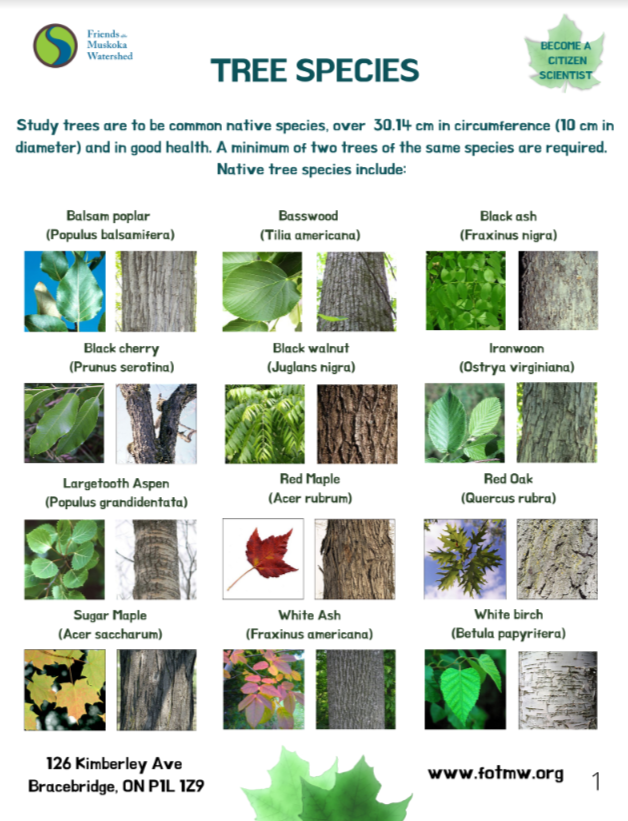News, Updates, and More
RESOURCES
CITIZEN SCIENCE RESOURCES
DATA COLLECTION GUIDE
Spreading Ash
Taking Foliage Samples
Taking Soil Samples
Measuring the Health of the Tree
Measuring Canopy Cover
Measuring Tree Height
Spreading Ash
Taking Foliage Samples
Taking Soil Samples
Measuring the Health of the Tree
Measuring Canopy Cover
Measuring Tree Height
FAQS
There are plenty of different ways you can protect your natural surroundings so that you can enjoy it for years to come.
For example, you could:
- Offset your carbon emissions from boating, travelling, and driving
- Collect your ash for upcoming ASHMuskoka ash drives
- Join our community of action-takers as a volunteer
- Become an FMW member to support the ongoing maintenance of our current and future programs
Despite the community-wide action already taking place, there’s always more to be done. Here are some other emerging ecological threats currently facing our watershed:
- More algal blooms (HABs) despite low and falling phosphorus
- Calcium decline in about half of Muskoka’s lakes
- Invasive species, like the spiny water flea
- Road salt is increasing chloride levels in many local lakes, including Lake Muskoka
- Climate change is causing more ice-free seasons
FMW currently has three programs working to protect and preserve the Muskoka environment you know and love. Those programs are:
HATSEO: Now complete, HATSEO assessed the viability of using ash to replenish calcium in the watershed.
ASHMuskoka: The next phase in HATSEO and addressing Muskoka’s calcium deficiency.
Road Salt Management: Addressing the increasing chloride levels in Muskoka lakes.
Want to learn more about our active programs? Click Here.
HATSEO: Now complete, HATSEO assessed the viability of using ash to replenish calcium in the watershed.
ASHMuskoka: The next phase in HATSEO and addressing Muskoka’s calcium deficiency.
Road Salt Management: Addressing the increasing chloride levels in Muskoka lakes.
Want to learn more about our active programs? Click Here.
It will take roughly four tonnes of ash per hectare (3,569 lbs per acre ) over many thousands of hectares to restore the calcium balance. While that is far more ash than Muskoka residents produce, the lessons learned in the three-year ASHMuskoka study will be used to help develop a province-wide ash recycling program, to bring wood ash from southern Ontario.
Wood ash is about 1/3 calcium by weight, and also contains many other key nutrients. Much of it is absorbed into the soil and quickly taken up by trees and other plants. What isn’t absorbed by the plants will make its way into the lakes.
No. This problem is most severe in areas with thin soils, granite bedrock, and a history of acid rain exposure. These specific conditions leave Muskoka and other parts of central Ontario uniquely positioned to feel the full force of this problem.
All life needs calcium. For Muskoka this problem affects:
Forests. They’re about 2% calcium by weight, and when calcium isn’t available, the trees and other forest plants can’t grow as quickly or efficiently. When trees aren’t growing as quickly, they can’t capture carbon as efficiently, impacting their ability to help fight climate change.
Aquatic creatures. Calcium is particularly important to hard-shelled creatures like crayfish, turtles, and molluscs. In fact, crayfish diversity in many lakes has already declined by 25%. In lakes, these tiny crustacea and molluscs often act as filter-feeders, performing a vital function in cleaning our waterways.
A century of acid rain and historically poor logging practices have flushed calcium from the soil and from the lakes and rivers. Most of Muskoka’s lakes have lost 25% to 50% of the calcium they need.
Despite the improvement of these issues, it will take centuries for calcium levels to rebound without further intervention.
Good question. Increasing algal blooms are influenced by three main factors:
- A better habitat for algal growth, largely impacted by climate change
- Faster algal growth, caused by a variety of factors including increasing phosphorus levels
- Lower algal death rates, caused by the decreasing zooplankton population
Yes, history has shown us that with patience and persistence ecological damage can be reversed. It’s complicated, but not impossible.
At a very highlevel, here’s how reversing ecological damage happens:
- Identify the threats
- Understand the steps that need to be taken
- Marshal the will for action in your community

